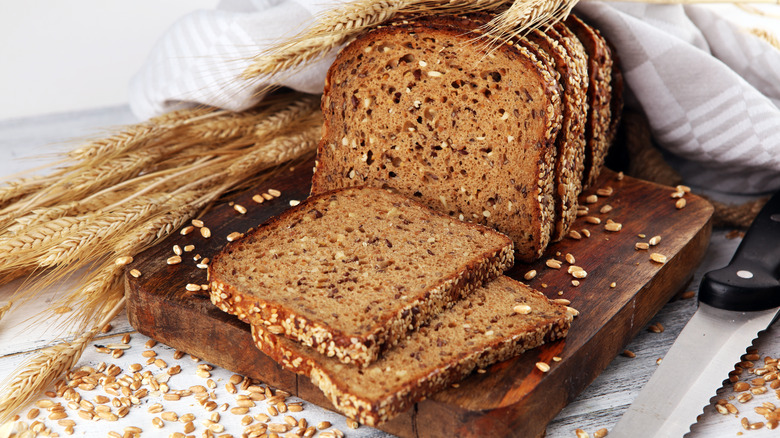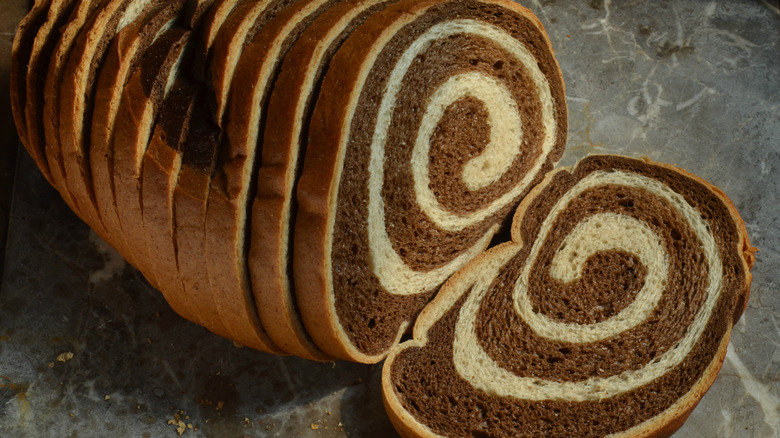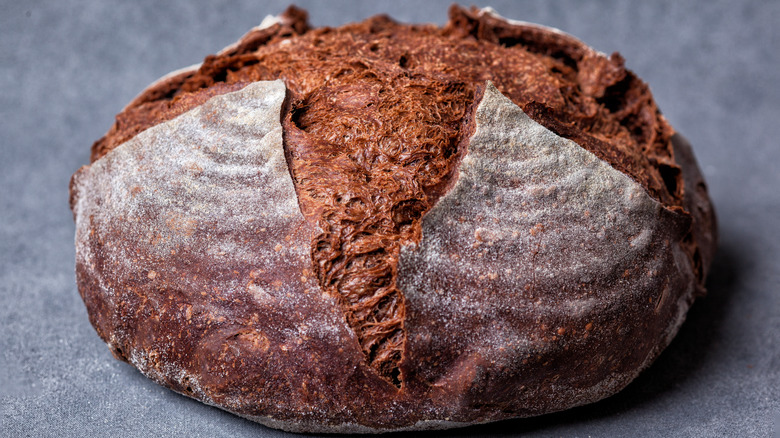Rye Vs. Pumpernickel: What's The Difference?
To the untrained eye, rye and pumpernickel bread may seem pretty similar. They both can be a dark brown color, are commonly spread with cream cheese, and are known for having slightly unusual flavors compared to other breads. As it turns out, it can be easy to mistake rye bread for pumpernickel and vice versa. And as demand for rye bread is on the rise, according to the New York Times, this predicament may become more and more prevalent.
Additionally, both of these breads come from Germany, where rye bread was stumbled upon after a crop failure (via the Great Basin Bakery Shop). Pumpernickel was actually named after the bread's flatulence-inducing (or shall we say gastronomic?) characteristics — the word "pumpernickel" comes from German words that translate roughly to "the devil's fart" (via HuffPost).
That's where the similarities end, however. Beneath the surface, rye and pumpernickel bread actually differ quite a bit in terms of their tastes, colors, nutritional content, and more.
Rye breads: a plethora of flavors and colors
In fact, pumpernickel bread is a type of rye bread. The umbrella of rye bread includes pumpernickel, Jewish rye, dark rye, and light rye, all of which are made with rye grains. Because of this, rye bread can have a variety of flavors and textures, depending on which type it is.
Light rye is the mildest of the bunch, notes The Kitchn, while dark rye generally contains additives like molasses or cocoa powder, which can lend to a more intense flavor and color. If you're looking for a compromise between the two, try marbled rye bread, which is just light and dark rye dough rolled together (via The Kitchn). All rye bread has a combination of sour, sweet, and earthy flavors.
No matter which rye bread you choose, you'll likely to find a healthy option. Although the nutritional content in rye varies depending on which type it is, according to Healthline, rye bread is high in fiber and may help improve heart health, digestive health, and blood sugar control. Healthline also noted that rye may provide more micronutrients and may be more filling than whole wheat bread.
Pumpernickel bread: strong, sour, and sweet
Pumpernickel is a type of rye bread known for its dark brown color and sour and sweet flavors, which are generally stronger than in other types of rye. Since it is a rye bread, pumpernickel is considered to be a healthy choice, although it differs slightly in health benefits compared to other types of ryes. According to VeryWell Fit, a slice of pumpernickel bread contains 2.1 g of fiber, slightly more than the 1.9 g of fiber Heathline listed for rye bread.
If this sounds appealing, you may want to try making pumpernickel at home. Baking a traditional loaf of pumpernickel is not for the faint of heart, however, as it can take over a day to finish (via the German Food Guide), much longer than other types of rye; Simply Recipes only clocks 70 minutes to make rye. According to the German Food Guide, the traditional recipe is made from rye meal, which needs to be boiled for hours to soften. Then after baking, loaves of pumpernickel need to steam for 16 to 24 hours to solidify their color and sweetness.
It's a hefty process, but the benefits of pumpernickel bread are worth it to some, while others prefer the lighter color and milder flavor of other types of rye. Which one will you choose to spread with schmear or other toppings?


